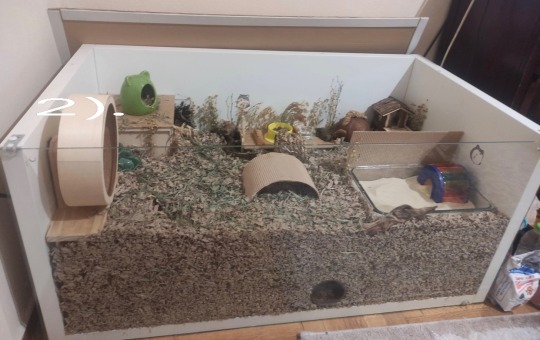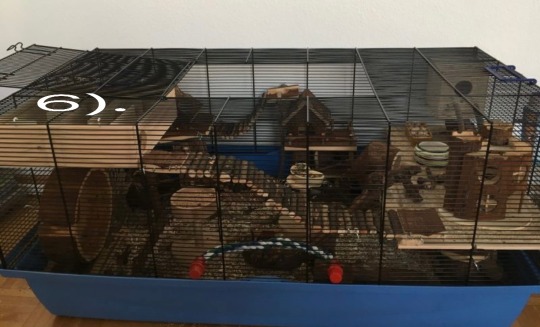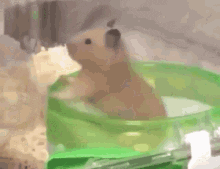Welcome! This is a page created for people to support one another with our smaller furry-babies! As someone who has had experience with hamsters I understand the want to give them the best life possible in the short time they have, so it’s my hope we can come together to learn more ourselves and to help others!🐹❤️
Don't wanna be here? Send us removal request.
Text
Diabetes in Hamsters
~I would like to add that I’m not a vet/animal professional, if you have concerns about your hammie’s health seeing a vet is a must! This post is purely about my own experience, in the hopes it might help someone and their pet who are going through the same thing.~
My little guy is a Russian dwarf hamster, he’s diabetic in addition to being albino, but it he doesn’t seem to let this get the best of him in any way!
Although diabetes is more common in dwarf hamsters, it’s something that can affect any pet. Despite being notified of this common condition by websites, videos, vets and pet shop workers; I feel there’s a concerning lack of information on the topic.
I personally scoured through countless websites and videos on how to help my current hamster with his condition but had little to no luck, not even my vet knew what to do. In fact they quite honestly told me they had no experience or knowledge on the condition.
I phoned multiple vets to enquire if they could help and was told the same thing, and had truthly began to lose some hope until I was recommended an exotic vet.
If you find yourself in a similar situation, or suspect your hamster might be diabetic, I would 100% recommend going to see an exotic vet for your little one.
It wasn’t the cheapest, all in all I believe I was about £80 for a check-up and a urine test, but PLEASE don’t let this out you off, as the experience and knowledge these vets have compared to regular vets was worth every penny.
Some common symptoms to look out for include, (but are not limited to);
-Excessive thirst
-Excessive urination
-Weight loss
-Cataracts
These symptoms can also be signs of other conditions and illnesses so a trip to the vet is best to rule out possibilities and help your hamster best.
I was given two options by my vet;
1): the option of starting my hamster on insulin; which would require me to administer at least one dose of insulin a day
2): to leave him as he is and monitor him and his condition daily
Options 1 can be costly in the long run, (the cost itself wasn’t an issue for me, but rather what damage I could possibly do). Insulin would cost about £25-£30 a month, and the medication itself can only be kept for about a month so this would be a monthly finance for anyone considering this.
I decided to go with option 2, as me and my vet thought this would provide a calmer life for him. Although option 1 was tempting, I could potentially run the risk of over or under dosing him. Additionally, I was concerned about the impact holding him down and injecting him with a needle (possibly more than once a day), would do to his well-being and to our relationship.
He runs to greet me if he hears me nearby, and is happy to sit on my hand to come out of the cage. I was worrried that this would make him fearful of me and being out and about in his home, something hitch would impact my ability to check his weight, and cleaning.
As it stands my little guy has his sand box cleaned out everyday, and his bedding is done every other day due to his excessive urination.
His sand box also used to be every other day, however I noticed mould starting to grow one day when cleaning, (simply due to the amount of urine he would produce), so that routine was quickly changed.
His bedding admittedly isn’t as excessive as it should be, however with a wider area to clean the risk of missing spots when cleaning (and running the risk of amonia build up and mould), was simply not worth it in my mind.
Additionally, it would stress him out more as bigger-clean outs would be required far more often, and he’s not too fond of having his home turned upside down as I’m sure any hamster owner knows.
He’s quite content though, rest assured my hammie has adequate room and enrichment in his home. Deep enough bedding to burrow, enrichment, different substrates, boredom’s breakers, etc.
How do I personally help my hamster, you might wonder?
-Regular checks and cleaning of his usual sleeping/hiding spots and sand box (toilet area)
-He has a water bottle in addition to x3 tea light holders placed in his usual hangout spots, to ensure he has easy and adequate access to fresh water. (Shallow tea lights are better for this, however placing a clean stone in the bottom of a deeper tea light can help avoid your hammie falling in).
-his weight is checked daily and written down, as well as how much he’s drinking
-getting a urine sample was also a suggestion from the vet, as this can help to give you an idea on things like blood sugar levels
-cutting out sugary snack, and avoiding food and hamster mixes with added sugar, (things like carrots and raisins are a no go for my little guy as a result)
-added protein to his diet; a good source of this is mealworms, egg, chicken, etc
-we also avoid hides with cramped awkward spaces, like mazes for example. He previously had one and I used hamster safe sealant to hopefully make it safer for him, however again mould made an appearance so I’d recommend watching out for these.
*something to note is my first vet gave me reusable cat litter in order to obtain a urine sample, however this was a big concern due to the risk of him consuming the fake litter. The exotic vet I went to recommended instead placing him in a carrier, with no absorbing materials/bedding, and wait for him to urinate. Personally this did break my heart a bit to watch, and he wasn’t too cooperative with the process.
I was also told by my vet that he may have a shorter life-span as a result of this, however this hasn’t stopped my little guy from living his best life. Like any other hamster he loves foraging, running, coming out for some one-on-one interaction, digging, chewing, etc.
He’s like any other hamster, and no matter how long he lives I’ll do my best to provide him a happy, safe and loving home.
I hope this has helped give someone who was also lost a bit of hope and guidance. Though again would like to say that I am in no way, shape or form a professional. I merely have my own personal experience with this matter.
I can only say how it’s been for me and my hamster, but every pet is different, and a vet should alway be the point of call for any health concerns you may have.
A healthy hamster is a happy hamster 🥰

0 notes
Text
Let’s talk unsuitable cages!
Hamster are not toys, not are they accessories!
They are living creatures with complex needs and requirements, and you as a hamster/rodent parent are responsible for ensuring they receive the care, attention and requirements they need and deserve to live a happy and healthy life!
Hamsters are wrongly seen as easy, cheap and low-maintenance pets to keep; this is very much not the case!
Providing your hamster with safe and appropriate accessories and bedding can be pricey, as can cages/enclosures that are suited for these little critters!
Cages such as;



When choosing a home for your hamster it is vital that you do your research and take into consideration the fact that they need floor space, deep bedding, plenty of hides & houses, different substrates, etc.
They may be small but they need plenty of room, more room than most people realise or consider. Hamsters are by nature prey animals so having the space to provide enough materials for them to burrow and hide in is important!
A big cage/enclosure = A happy hamster
Unsuitable cages can be dangerous in more ways than one, they can harms hamsters…
Physically
Emotionally
And mentally!!
🐹❤️
***I don’t own these images, all credit for photos goes to their rightful creators***
1 note
·
View note
Text
Hamster Homes!!!
When it comes to hamsters bigger is always better!
Hamster cages should be at least 600 square inches; for example a cage 100cm x 50cm works out at about 740 square inches!
However hamsters will thrive in cages that are bigger than this! Too small cages can have a detrimental effect of your hamster, (or even mouse, Guinea pig, degu, gerbil, rat, etc), so it’s important to take their needs into consideration.
For example for my dwarf hamster I converted a detolf case from ikea into an enclosure, and she absolutely loves it! The uninterrupted floor space is very ideal for hamsters as they are very active little critters when they want to be, and so the more space they have to utilise and explore the better!
Please also bare in mind that the majority of cages sold in pet shops are, believe it or not, not ideal for hamsters. Most of them are far too small, both in cage sizes and more often than not the wheels/accessories provided.
Making sure you have these basic needs met can avoid dangerous and stress related behaviours like bat climbing and biting! So you’ll be able to rest assured that your hammie won’t hurt themselves, or keep you up with the sound of chewing!
Things to also consider when choosing your furry friend’s home is that there will be enough room also for bedding! Hamsters love to dig and burrow, so ensuring you provide deep enough bedding for them to do so is also important!
Not only will it help them to instinctively dig and burrow, it also provides warmth for them and helps them to feel more secure!
Some ideal examples as followed, but not limited to;







1). IKEA detolf conversion
2). IKEA Linnmon conversion
3). Pawhut Enclosure
4). Aquarium tank conversion (40 gallon tanks are usually about 640 square inches, so the bigger the better)!
5). Niteangel bigger world MDF terrarium
6). Barney hamster cage
7). Savic Plaza
A good video on YouTube to check out is; BEST hamster cages of 2021 by Victoria Raechel
Her channel is very informative for both new and experienced hamster parents!
Please feel free to share your own experiences with hamster cages and enclosures! Please add the hashtag #HamsterHomes to make navigation easier if you’d like to share, thank you!
🐹❤️
***I don’t own these images, all credit for these wonderful set-ups go to their rightful owners!***
13 notes
·
View notes
Text

Hello & Welcome!! Over the course of my journey and experiences with hamster care I’ve learned so much, things I’d wished I’d known longer and as a result I’d love to create a community (no matter how big or small), where we can all come together to support one another and share the things we’ve learned!
I’d love a place where hamster/rodent lovers can come together to help and support one another! Everyone and anyone is more than welcome to comment or make posts, however all of any comments must be constructive and fair!
The welfare and happiness of our small friends is essential here, and I’d appreciate it if we could stick together and support one another in our own journey of rodent care, topics for this include but aren’t limited to;
🐹 - Enclosure types and their size! {#HamsterHomes}
🐹 - Enrichment!
🐹 - Activities!
🐹 - Suitable substrate!
🐹 - Care advice!
🐹 - Suitable foods (Fresh and Dry!)
🐹 - Cleaning
🐹 - Behaviours and Habits!
🐹 - Recommended Products!
🐹 - Or just to show off your furry babies!
I myself am NOT an expert, this is just a hamster parent sharing what she’s learned over the years, and I’d love for others to do the same! It’s been trial and error, I myself have made mistakes but without knowledge how will we improve? Thank you!! 😊🐹❤️
#rodent care#hamsters#Syrian hamster#dwarf hamster#gerbil#mouse#hamster care#mice#advice#hamster advise#cute#hamster community#rodent community#hamster cage#hamster food#rodent cage#hamster enrichment
4 notes
·
View notes